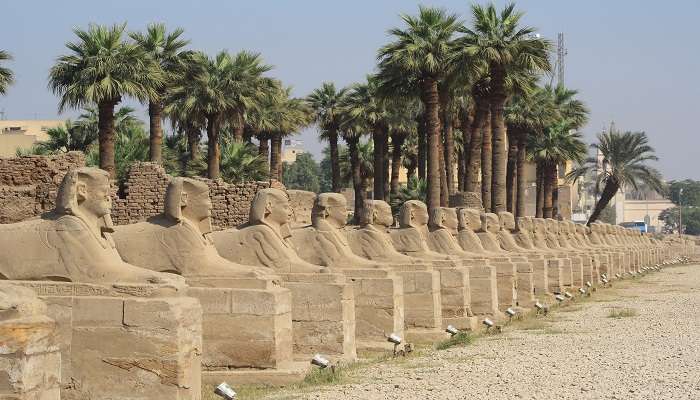Exploring The Magnificence Of The Avenue Of Sphinx In Luxor

Stretching for over 3 Km, the Avenue of Sphinx stands as an awe-inspiring remnant of ancient Egypt’s engineering prowess. This grand processional way once connected the iconic temples of Karnak and Luxor, forming the sacred heart of Thebes. A haunting parade of ram-headed sphinxes lines the path, sculpted stone sentinels paying homage to ancient gods. Over 1,057 of these leonine statues create a spectacle that has endured through millennia. With the Nile’s life-giving waters nearby, the avenue offers a mesmerizing glimpse into an ancient civilization’s religious beliefs and architectural ingenuity.
About Avenue Of Sphinx

The majestic Avenue of Sphinxes, also called the King’s Festivities Road or Rams Road, is an ancient thoroughfare of great historical importance. Stretching over 2.7 Km (1.7 miles), it forms a direct link between the Karnak and Luxor Temples in what was once Thebes, now known as Luxor. Adorned with an array of statues, mainly sphinxes bearing the heads of rams and humans, it stands as a testament to ancient Egyptian rulers’ power and religious prominence.
Must Read: Museums In Egypt
Avenue Of Sphinx History

The Avenue of Sphinxes is a monumental road linking the Luxor and Karnak temples in Egypt, constructed initially during the New Kingdom era and completed under the 30th Dynasty ruler Nectanebo I (380–362 B.C.). Over the centuries, the road was buried under layers of sand. The first trace of the Avenue at Luxor was found in 1949 by Mohammed Zakaria Ghoneim, an Egyptian archaeologist, who found eight statues near the Luxor Temple. Between 1958 and 1961, 17 more statues were uncovered, followed by 55 statues from 1961 to 1964, all within a 250-meter perimeter. From 1984 to 2000, the entire walkway route was mapped out, leading to extensive excavations. The Avenue of Sphinxes in Luxor, Egypt, had a big reopening party on 25 November 2021. This was after they spent over 70 years fixing it up. The party was fancy, with people dressed up like ancient Egyptians, an orchestra playing music, lots of lights, and dancing.
Opening Hours And Entrance Fees

The Avenue of Sphinxes in Luxor is an extraordinary historical landmark, serving as a link between the Karnak and Luxor temples. It is open from 6:00 a.m. to 10:00 p.m. every day, allowing ample time to explore its wonders.
The entrance fee is 160 Egyptian Pounds. A journey along this avenue is akin to a walk through the annals of history, flanked by the grandeur of sphinx statues. To truly immerse oneself in the experience, it is advisable to spend approximately two hours at the site.
Suggested Read: Trip To Egypt
Best Time To Visit The Avenue Of Sphinx

Visiting the Avenue of Sphinxes is most delightful from October through April. This timeframe offers a reprieve from the summer’s scorching temperatures, making it perfect for outdoor exploration. To experience the avenue at its best, aim for the early morning to sidestep the intense afternoon sun. Alternatively, an evening stroll presents a different charm, with the sphinx-lined route and ancient temples illuminated against the night sky, all while a gentle Nile breeze enhances the ambience.
How To Reach Avenue Of Sphinx?

You can reach the Avenue of Sphinx in Luxor through various modes of transportation. Some of the ways to reach the Avenue of Sphinxes are as follows:
- On Foot: The Avenue of Sphinxes is designed to be pedestrian-friendly. It offers a historical stroll along the 2.7 km (1.7 miles) path linking the Karnak Temple with the Luxor Temple. As you traverse this ancient road, benches and rest areas are available for visitors to relax and soak in the surroundings.
- By Car: For those preferring to drive, convenient parking facilities are accessible near both the Karnak and Luxor Temples. You have the flexibility to begin your exploration from either temple, as they both serve as gateways to the Avenue of Sphinxes.
- By Taxi: Taxis provide a quick and easy way to reach the Avenue of Sphinxes, with drivers ready to take you to the entrance of either Karnak or Luxor Temples. To ensure a smooth ride, it’s recommended to negotiate the fare with the taxi driver beforehand.
For a touch of tradition, consider a ride in a horse-drawn carriage. These charming modes of transport can be found along the corniche, ready to transport you to the Avenue of Sphinxes for an unforgettable experience.
Further Read: Winter In Egypt
The Avenue of Sphinx in Luxor, Egypt, is a mesmerising ancient marvel that transports visitors back in time. Walking along the awe-inspiring path, flanked by towering ram-headed sphinxes, evokes a profound sense of reverence for the grandeur of Egyptian civilization. This iconic avenue is a testament to the ancient Egyptians’ incredible engineering and artistic prowess, leaving an indelible impression on all who witness its magnificence. So, plan your trip to Egypt today and immerse yourself in its captivating allure.
For our editorial codes of conduct and copyright disclaimer, please click here.
Cover Image Credit: By ianpudsey for Wikimedia Commons
Frequently Asked Questions About Avenue of Sphinx
Can you walk the Avenue of the Sphinxes?
Yes, visitors can stroll along the full 3 km of the Avenue of Sphinxes, which links the Karnak and Luxor temple complexes.
How long is the avenue of the Sphinx?
The Avenue of Sphinxes stretches roughly 2.7 km (1.7 miles) and forms a grand promenade embellished with these mysterious mythical beings. This impressive pathway symbolises the rich cultural heritage and spiritual significance of ancient Egypt, captivating visitors with its timeless allure.
Is there a tomb inside the Sphinx?
Yes, there's speculation of a hidden tomb beneath the Avenue of Sphinxes. Certain archaeologists claim evidence supporting this theory. This enigmatic possibility adds an intriguing layer to the avenue's historical significance and its role in ancient Egyptian civilization.
Can tourists touch the Sphinx?
No, tourists are not allowed to touch the Sphinx. Regulations are in place to protect the structure, and visitors must follow guidelines to prevent damage to the monument.
What is the Sphinx Avenue?
The Sphinx Avenue, also known as the Avenue of Sphinxes or The King’s Festivities Road, is a processional route connecting the Karnak Temple with the Luxor Temple in ancient Thebes, Egypt. Lined with sphinxes and ram-headed statues, it was used for ceremonial processions during ancient times.
People Also Read:
Things To Do In Egypt Things To Do In Bursa Things To Do In Cairo

Unveil the hidden treasures of the globe and turn every travel dream into reality. As a Content Writer, I am passionate enough to craft stories from ancient wonders to modern marvels. My words paint the picture-perfect itinerary for unforgettable experiences. Let my words be your trusted guide to immerse in the diverse culture and discover the beauty of the unknown.











